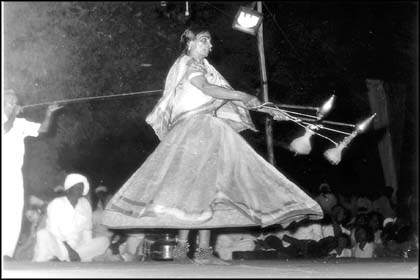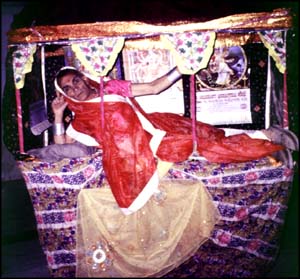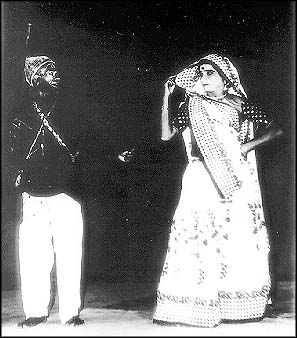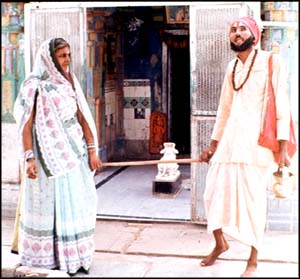T R A D I T I O N A L P E R F O R M A N C E
After the actor's preparation, musicians come to the performance place, usually a circle drawn by water or oil on the ground. This area is purified with sprinkles of red kum kum powder and sandalwood powder. Then the musicians begin to sing prayers and traditional songs. The loud sound of the bhungal horns and singing notifies people int the area that a performance is beginning soon. The audience gathers around the sacred circle and the village barber lights a huge torch to illuminate the acting area. Female characters hold small burning torches in their hands which they position near their faces for illumination of expression. The village leader signals the start of the show and the actors enter. All performances begin with the Ganapati Vesha to honor the diety Ganesha.
There are four types of traditional veshas; religious themes and characters, historical events and characters, social situations, and skills veshas involving physical dexterity and magic tricks. Social veshas encompass a variety of themes such as adultery, fake gurus, government and corruption, and harmful local social traditions.
From its beginnings in the 14th century until the late 20th century, Bhavai was traditionally performed with a cast of three men. Only in very recent times have women performed and these are professionally trained actresses from urban areas.
All traditional veshas have the same structure as follows:
A. Each character enters separately to introduce himself to the audienc by using his character's specific song, dance, music, and narration.
B. After the characters are introduced, a conflict evolves amongst them.
C. The comic or tragic resolution of the conflict takes place.
Each Bhavai performance event contains several different veshas. The types of veshas chosen for the performance depend on the wishes of the audience, the sponsors of the event, the availability of actors, or the current season or holiday.
After the actor's preparation, musicians come to the performance place, usually a circle drawn by water or oil on the ground. This area is purified with sprinkles of red kum kum powder and sandalwood powder. Then the musicians begin to sing prayers and traditional songs. The loud sound of the bhungal horns and singing notifies people int the area that a performance is beginning soon. The audience gathers around the sacred circle and the village barber lights a huge torch to illuminate the acting area. Female characters hold small burning torches in their hands which they position near their faces for illumination of expression. The village leader signals the start of the show and the actors enter. All performances begin with the Ganapati Vesha to honor the diety Ganesha.
There are four types of traditional veshas; religious themes and characters, historical events and characters, social situations, and skills veshas involving physical dexterity and magic tricks. Social veshas encompass a variety of themes such as adultery, fake gurus, government and corruption, and harmful local social traditions.
From its beginnings in the 14th century until the late 20th century, Bhavai was traditionally performed with a cast of three men. Only in very recent times have women performed and these are professionally trained actresses from urban areas.
All traditional veshas have the same structure as follows:
A. Each character enters separately to introduce himself to the audienc by using his character's specific song, dance, music, and narration.
B. After the characters are introduced, a conflict evolves amongst them.
C. The comic or tragic resolution of the conflict takes place.
Each Bhavai performance event contains several different veshas. The types of veshas chosen for the performance depend on the wishes of the audience, the sponsors of the event, the availability of actors, or the current season or holiday.




